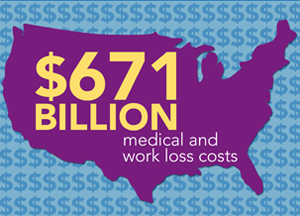Cost of Injuries and Violence in the United States
The total lifetime medical and work loss costs of injuries and violence in the United States was $671 billion in 2013. The costs associated with fatal injuries was $214 billion while nonfatal injuries accounted for over $457 billion.
Injuries, including all causes of unintentional and violence-related injuries combined, account for 59% of all deaths among people ages 1-44 years of age in the U.S.—that is more deaths than non-communicable diseases and infectious diseases combined. Injuries killed more than 199,800 in 2014—one person every three minutes.
Each year, millions of people are injured and survive. In fact, 2.5 million people are hospitalized, 26.9 million people are treated in emergency departments and released each year. These people are often faced with life-long mental, physical, and financial problems.

![]() Nearly $130 billion of the fatal injury costs were attributable to unintentional injuries, followed by suicide ($50.8 billion) and homicide ($26.4 billion).
Nearly $130 billion of the fatal injury costs were attributable to unintentional injuries, followed by suicide ($50.8 billion) and homicide ($26.4 billion).
![]() Drug poisonings, including prescription drug overdoses, accounted for 27% of fatal injury costs.
Drug poisonings, including prescription drug overdoses, accounted for 27% of fatal injury costs.
![]() Falls (37%) and transportation-related injuries (21%) accounted for the majority of costs treated in emergency departments.
Falls (37%) and transportation-related injuries (21%) accounted for the majority of costs treated in emergency departments.
![]() Males account for the majority (78%) of fatal injury costs ($166.7 billion) and nonfatal injury costs (63%; $287.5 billion).
Males account for the majority (78%) of fatal injury costs ($166.7 billion) and nonfatal injury costs (63%; $287.5 billion).
What Can Be Done?
Overview
For more than 20 years, CDC's Injury Center has helped protect Americans from violence and injury threats. We can work together to protect people from violence and injury.
Identifying and Monitoring the Problem
Using cutting-edge data systems to track injuries and deaths to better understand the nature and scope of the problem and ensure that prevention initiatives are guided by the best available data.
Conducting Research to Understand What Works
Conducting research to understand risk and protective factors and find what works to prevent injuries and violence, informing decision making about programs and policies to reduce violence and injuries.
Supporting National and State Programs
Supporting national and state injury programs to collect and use data, plan injury prevention and control efforts, and carry out and evaluate potentially life-saving interventions.
Raising Awareness and Educating
Raising awareness and educating health care providers, policy makers, public health practitioners, and the public so we can advance prevention initiatives and promote policies that save lives.
We Know What Works to Prevent Injury and Violence
At CDC’s Injury Center we have sharpened our focus on key injury and violence issues where we believe we can quickly have an impact in protecting Americans. Some examples of what can be done in these key areas include:
- Motor Vehicle Injury: Improving proper restraint use, including seat belts, child safety seats, and booster seats.
- Prescription Drug Overdose: Supplying healthcare providers with data, tools, and guidance for evidence-based decision making.
- Older Adult Falls: Making fall prevention a routine part of clinical care with tools for screening, assessing, treating, and following-up with patients.
- Child Abuse and Neglect: Ensuring children have safe, stable, nurturing relationships and environments.
- Youth Sports Concussion: Creating a culture of safety for youth sports; encouraging young athletes to report symptoms and providing concussion resources to coaches and parents.
- Sexual Violence: Using a comprehensive approach to promote respectful relationships, mobilize bystanders, empower women and girls, and create social and physical environments that are safe for all.
Learn More
- Ten Leading Causes of Death and Injury Charts
- WISQARS Cost of Injury Reports
- WISQARS Fatal Injury Data
- WISQARS Nonfatal Injury Data
- Estimated Lifetime Medical and Work-Loss Costs of Fatal Injuries — United States, 2013
- Estimated Lifetime Medical and Work-Loss Costs of Emergency Department-Treated Nonfatal Injuries — United States, 2013
Tools for Partners
- Page last reviewed: July 29, 2016
- Page last updated: July 29, 2016
- Content source:
- Centers for Disease Control and Prevention, National Center for Injury Prevention and Control


 ShareCompartir
ShareCompartir